Leadership, Management, and Operations: A Comprehensive Report
VerifiedAdded on 2022/12/30
|12
|3757
|29
Report
AI Summary
This report delves into the core concepts of leadership and management, exploring the distinctions between leaders and managers, their respective roles, and characteristics. It uses Sainsbury's, a major retail chain, as a case study. The report examines how leadership and management functions apply in diverse situational contexts, including change management, new product launches, and performance management. It then applies various leadership theories and models, such as situational, system, and contingency approaches. Furthermore, the report explains key approaches to operations management, including total quality management, six sigma, and just-in-time techniques, and analyzes the roles of leaders and managers in these processes. Finally, it assesses the impact of factors within the business environment on operational management and decision-making by leaders and managers, providing a comprehensive overview of leadership and management within an operational context.
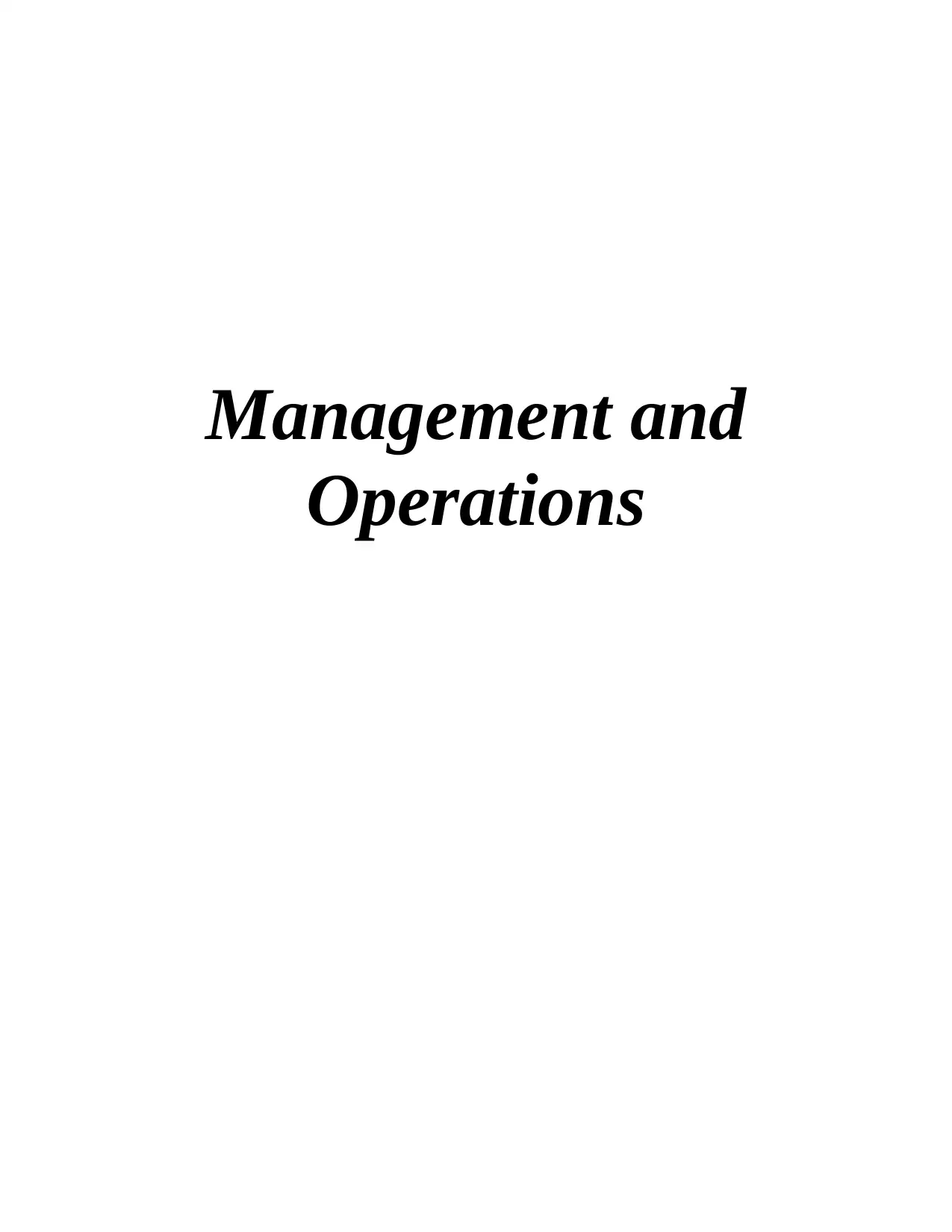
Management and
Operations
Operations
Paraphrase This Document
Need a fresh take? Get an instant paraphrase of this document with our AI Paraphraser
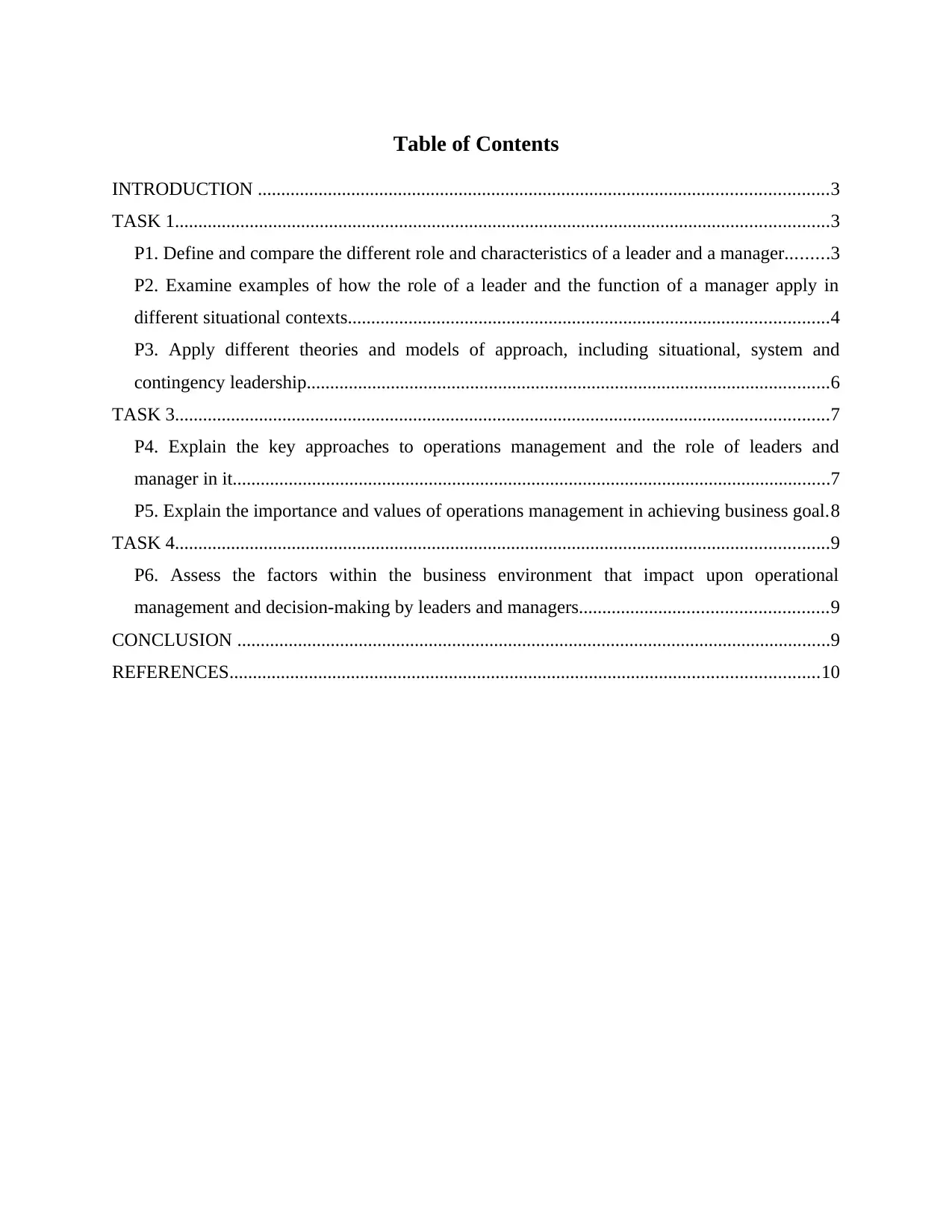
Table of Contents
INTRODUCTION ..........................................................................................................................3
TASK 1............................................................................................................................................3
P1. Define and compare the different role and characteristics of a leader and a manager.........3
P2. Examine examples of how the role of a leader and the function of a manager apply in
different situational contexts.......................................................................................................4
P3. Apply different theories and models of approach, including situational, system and
contingency leadership................................................................................................................6
TASK 3............................................................................................................................................7
P4. Explain the key approaches to operations management and the role of leaders and
manager in it................................................................................................................................7
P5. Explain the importance and values of operations management in achieving business goal.8
TASK 4............................................................................................................................................9
P6. Assess the factors within the business environment that impact upon operational
management and decision-making by leaders and managers.....................................................9
CONCLUSION ...............................................................................................................................9
REFERENCES..............................................................................................................................10
INTRODUCTION ..........................................................................................................................3
TASK 1............................................................................................................................................3
P1. Define and compare the different role and characteristics of a leader and a manager.........3
P2. Examine examples of how the role of a leader and the function of a manager apply in
different situational contexts.......................................................................................................4
P3. Apply different theories and models of approach, including situational, system and
contingency leadership................................................................................................................6
TASK 3............................................................................................................................................7
P4. Explain the key approaches to operations management and the role of leaders and
manager in it................................................................................................................................7
P5. Explain the importance and values of operations management in achieving business goal.8
TASK 4............................................................................................................................................9
P6. Assess the factors within the business environment that impact upon operational
management and decision-making by leaders and managers.....................................................9
CONCLUSION ...............................................................................................................................9
REFERENCES..............................................................................................................................10
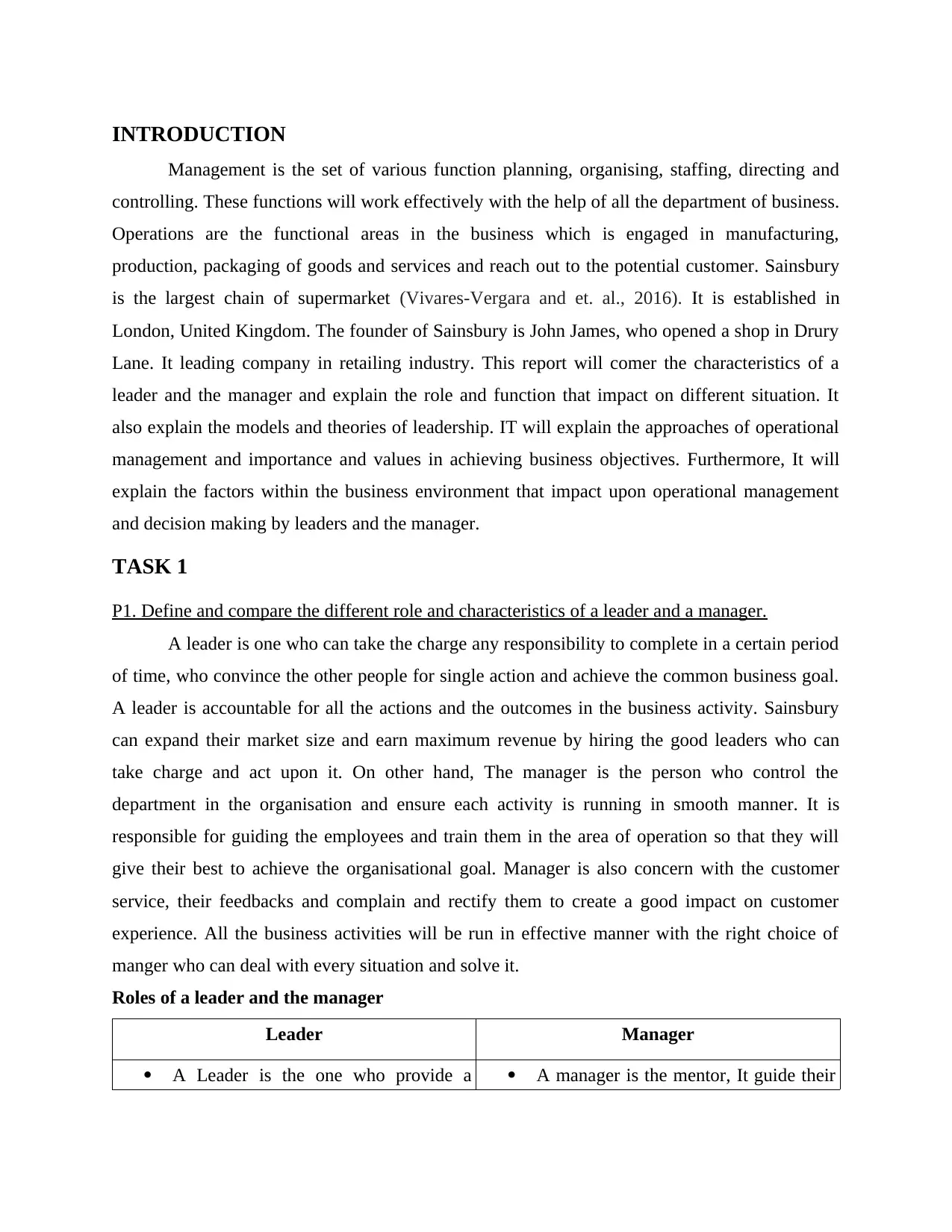
INTRODUCTION
Management is the set of various function planning, organising, staffing, directing and
controlling. These functions will work effectively with the help of all the department of business.
Operations are the functional areas in the business which is engaged in manufacturing,
production, packaging of goods and services and reach out to the potential customer. Sainsbury
is the largest chain of supermarket (Vivares-Vergara and et. al., 2016). It is established in
London, United Kingdom. The founder of Sainsbury is John James, who opened a shop in Drury
Lane. It leading company in retailing industry. This report will comer the characteristics of a
leader and the manager and explain the role and function that impact on different situation. It
also explain the models and theories of leadership. IT will explain the approaches of operational
management and importance and values in achieving business objectives. Furthermore, It will
explain the factors within the business environment that impact upon operational management
and decision making by leaders and the manager.
TASK 1
P1. Define and compare the different role and characteristics of a leader and a manager.
A leader is one who can take the charge any responsibility to complete in a certain period
of time, who convince the other people for single action and achieve the common business goal.
A leader is accountable for all the actions and the outcomes in the business activity. Sainsbury
can expand their market size and earn maximum revenue by hiring the good leaders who can
take charge and act upon it. On other hand, The manager is the person who control the
department in the organisation and ensure each activity is running in smooth manner. It is
responsible for guiding the employees and train them in the area of operation so that they will
give their best to achieve the organisational goal. Manager is also concern with the customer
service, their feedbacks and complain and rectify them to create a good impact on customer
experience. All the business activities will be run in effective manner with the right choice of
manger who can deal with every situation and solve it.
Roles of a leader and the manager
Leader Manager
A Leader is the one who provide a A manager is the mentor, It guide their
Management is the set of various function planning, organising, staffing, directing and
controlling. These functions will work effectively with the help of all the department of business.
Operations are the functional areas in the business which is engaged in manufacturing,
production, packaging of goods and services and reach out to the potential customer. Sainsbury
is the largest chain of supermarket (Vivares-Vergara and et. al., 2016). It is established in
London, United Kingdom. The founder of Sainsbury is John James, who opened a shop in Drury
Lane. It leading company in retailing industry. This report will comer the characteristics of a
leader and the manager and explain the role and function that impact on different situation. It
also explain the models and theories of leadership. IT will explain the approaches of operational
management and importance and values in achieving business objectives. Furthermore, It will
explain the factors within the business environment that impact upon operational management
and decision making by leaders and the manager.
TASK 1
P1. Define and compare the different role and characteristics of a leader and a manager.
A leader is one who can take the charge any responsibility to complete in a certain period
of time, who convince the other people for single action and achieve the common business goal.
A leader is accountable for all the actions and the outcomes in the business activity. Sainsbury
can expand their market size and earn maximum revenue by hiring the good leaders who can
take charge and act upon it. On other hand, The manager is the person who control the
department in the organisation and ensure each activity is running in smooth manner. It is
responsible for guiding the employees and train them in the area of operation so that they will
give their best to achieve the organisational goal. Manager is also concern with the customer
service, their feedbacks and complain and rectify them to create a good impact on customer
experience. All the business activities will be run in effective manner with the right choice of
manger who can deal with every situation and solve it.
Roles of a leader and the manager
Leader Manager
A Leader is the one who provide a A manager is the mentor, It guide their
⊘ This is a preview!⊘
Do you want full access?
Subscribe today to unlock all pages.

Trusted by 1+ million students worldwide
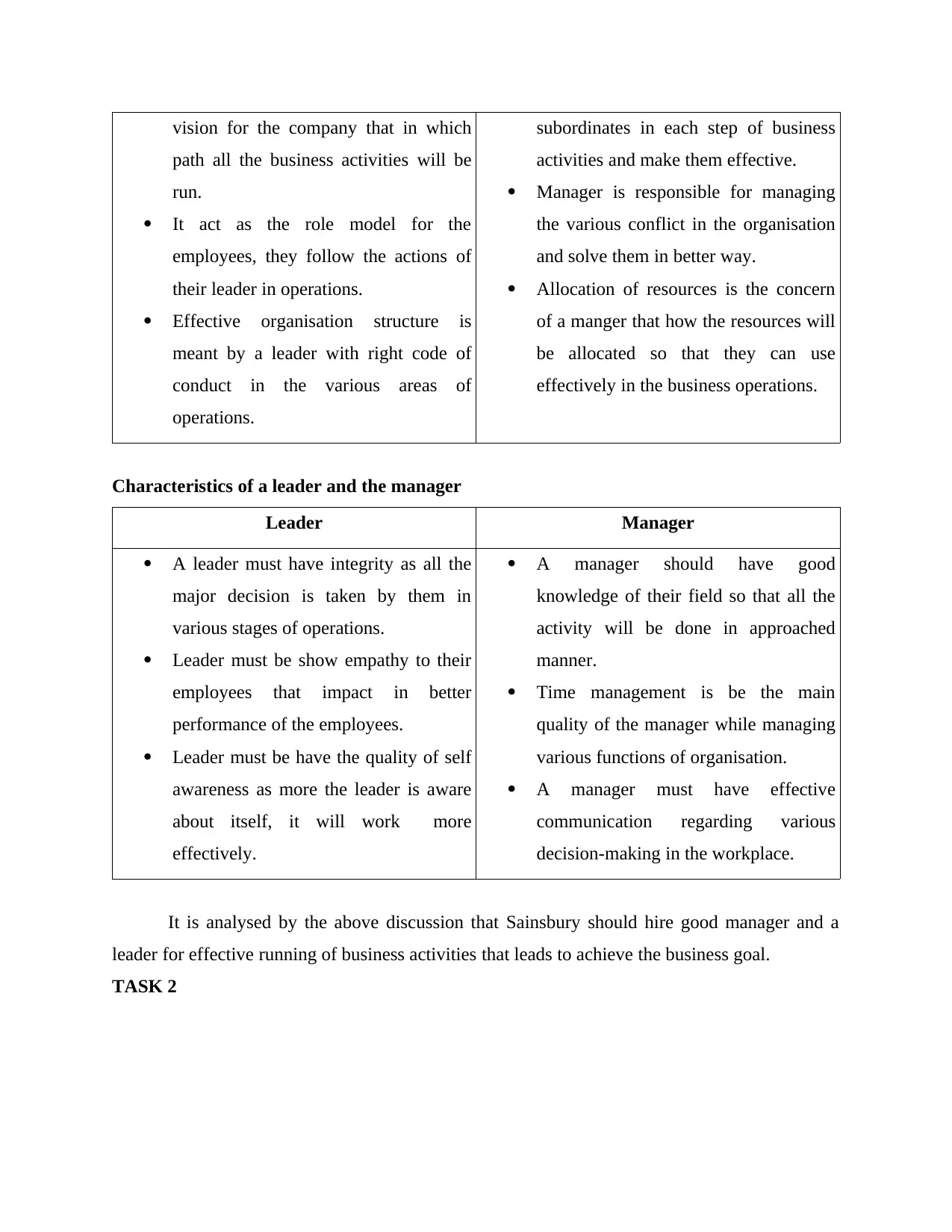
vision for the company that in which
path all the business activities will be
run.
It act as the role model for the
employees, they follow the actions of
their leader in operations.
Effective organisation structure is
meant by a leader with right code of
conduct in the various areas of
operations.
subordinates in each step of business
activities and make them effective.
Manager is responsible for managing
the various conflict in the organisation
and solve them in better way.
Allocation of resources is the concern
of a manger that how the resources will
be allocated so that they can use
effectively in the business operations.
Characteristics of a leader and the manager
Leader Manager
A leader must have integrity as all the
major decision is taken by them in
various stages of operations.
Leader must be show empathy to their
employees that impact in better
performance of the employees.
Leader must be have the quality of self
awareness as more the leader is aware
about itself, it will work more
effectively.
A manager should have good
knowledge of their field so that all the
activity will be done in approached
manner.
Time management is be the main
quality of the manager while managing
various functions of organisation.
A manager must have effective
communication regarding various
decision-making in the workplace.
It is analysed by the above discussion that Sainsbury should hire good manager and a
leader for effective running of business activities that leads to achieve the business goal.
TASK 2
path all the business activities will be
run.
It act as the role model for the
employees, they follow the actions of
their leader in operations.
Effective organisation structure is
meant by a leader with right code of
conduct in the various areas of
operations.
subordinates in each step of business
activities and make them effective.
Manager is responsible for managing
the various conflict in the organisation
and solve them in better way.
Allocation of resources is the concern
of a manger that how the resources will
be allocated so that they can use
effectively in the business operations.
Characteristics of a leader and the manager
Leader Manager
A leader must have integrity as all the
major decision is taken by them in
various stages of operations.
Leader must be show empathy to their
employees that impact in better
performance of the employees.
Leader must be have the quality of self
awareness as more the leader is aware
about itself, it will work more
effectively.
A manager should have good
knowledge of their field so that all the
activity will be done in approached
manner.
Time management is be the main
quality of the manager while managing
various functions of organisation.
A manager must have effective
communication regarding various
decision-making in the workplace.
It is analysed by the above discussion that Sainsbury should hire good manager and a
leader for effective running of business activities that leads to achieve the business goal.
TASK 2
Paraphrase This Document
Need a fresh take? Get an instant paraphrase of this document with our AI Paraphraser
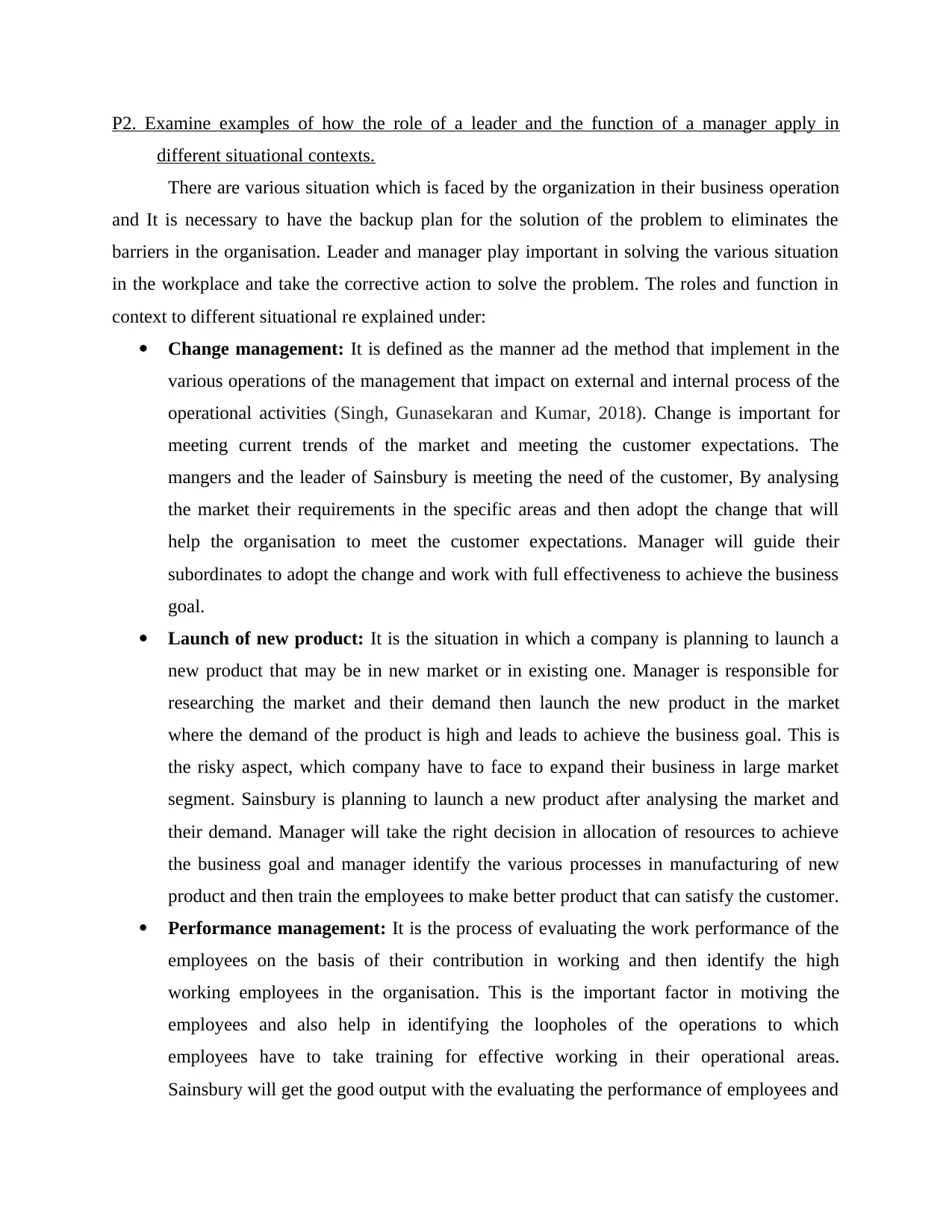
P2. Examine examples of how the role of a leader and the function of a manager apply in
different situational contexts.
There are various situation which is faced by the organization in their business operation
and It is necessary to have the backup plan for the solution of the problem to eliminates the
barriers in the organisation. Leader and manager play important in solving the various situation
in the workplace and take the corrective action to solve the problem. The roles and function in
context to different situational re explained under:
Change management: It is defined as the manner ad the method that implement in the
various operations of the management that impact on external and internal process of the
operational activities (Singh, Gunasekaran and Kumar, 2018). Change is important for
meeting current trends of the market and meeting the customer expectations. The
mangers and the leader of Sainsbury is meeting the need of the customer, By analysing
the market their requirements in the specific areas and then adopt the change that will
help the organisation to meet the customer expectations. Manager will guide their
subordinates to adopt the change and work with full effectiveness to achieve the business
goal.
Launch of new product: It is the situation in which a company is planning to launch a
new product that may be in new market or in existing one. Manager is responsible for
researching the market and their demand then launch the new product in the market
where the demand of the product is high and leads to achieve the business goal. This is
the risky aspect, which company have to face to expand their business in large market
segment. Sainsbury is planning to launch a new product after analysing the market and
their demand. Manager will take the right decision in allocation of resources to achieve
the business goal and manager identify the various processes in manufacturing of new
product and then train the employees to make better product that can satisfy the customer.
Performance management: It is the process of evaluating the work performance of the
employees on the basis of their contribution in working and then identify the high
working employees in the organisation. This is the important factor in motiving the
employees and also help in identifying the loopholes of the operations to which
employees have to take training for effective working in their operational areas.
Sainsbury will get the good output with the evaluating the performance of employees and
different situational contexts.
There are various situation which is faced by the organization in their business operation
and It is necessary to have the backup plan for the solution of the problem to eliminates the
barriers in the organisation. Leader and manager play important in solving the various situation
in the workplace and take the corrective action to solve the problem. The roles and function in
context to different situational re explained under:
Change management: It is defined as the manner ad the method that implement in the
various operations of the management that impact on external and internal process of the
operational activities (Singh, Gunasekaran and Kumar, 2018). Change is important for
meeting current trends of the market and meeting the customer expectations. The
mangers and the leader of Sainsbury is meeting the need of the customer, By analysing
the market their requirements in the specific areas and then adopt the change that will
help the organisation to meet the customer expectations. Manager will guide their
subordinates to adopt the change and work with full effectiveness to achieve the business
goal.
Launch of new product: It is the situation in which a company is planning to launch a
new product that may be in new market or in existing one. Manager is responsible for
researching the market and their demand then launch the new product in the market
where the demand of the product is high and leads to achieve the business goal. This is
the risky aspect, which company have to face to expand their business in large market
segment. Sainsbury is planning to launch a new product after analysing the market and
their demand. Manager will take the right decision in allocation of resources to achieve
the business goal and manager identify the various processes in manufacturing of new
product and then train the employees to make better product that can satisfy the customer.
Performance management: It is the process of evaluating the work performance of the
employees on the basis of their contribution in working and then identify the high
working employees in the organisation. This is the important factor in motiving the
employees and also help in identifying the loopholes of the operations to which
employees have to take training for effective working in their operational areas.
Sainsbury will get the good output with the evaluating the performance of employees and
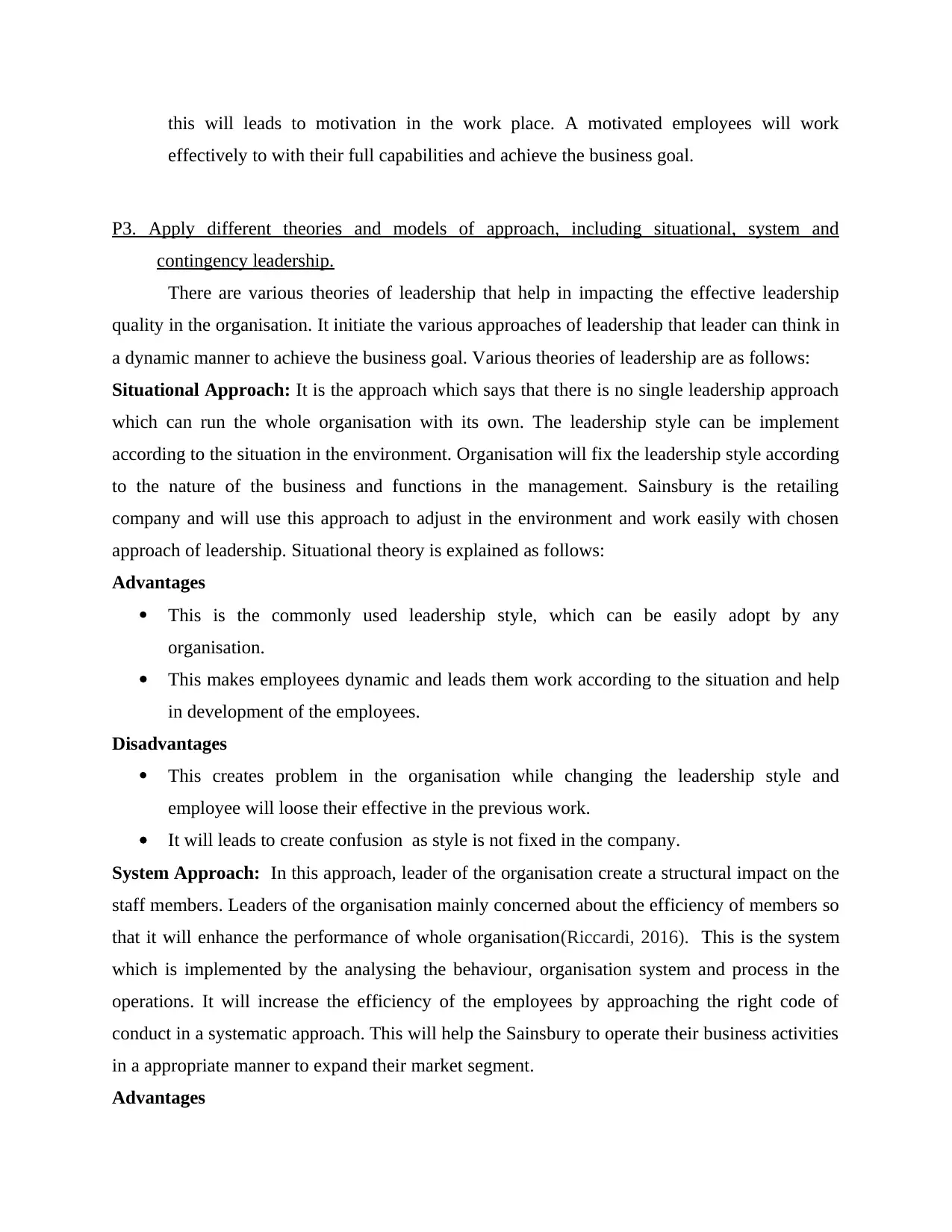
this will leads to motivation in the work place. A motivated employees will work
effectively to with their full capabilities and achieve the business goal.
P3. Apply different theories and models of approach, including situational, system and
contingency leadership.
There are various theories of leadership that help in impacting the effective leadership
quality in the organisation. It initiate the various approaches of leadership that leader can think in
a dynamic manner to achieve the business goal. Various theories of leadership are as follows:
Situational Approach: It is the approach which says that there is no single leadership approach
which can run the whole organisation with its own. The leadership style can be implement
according to the situation in the environment. Organisation will fix the leadership style according
to the nature of the business and functions in the management. Sainsbury is the retailing
company and will use this approach to adjust in the environment and work easily with chosen
approach of leadership. Situational theory is explained as follows:
Advantages
This is the commonly used leadership style, which can be easily adopt by any
organisation.
This makes employees dynamic and leads them work according to the situation and help
in development of the employees.
Disadvantages
This creates problem in the organisation while changing the leadership style and
employee will loose their effective in the previous work.
It will leads to create confusion as style is not fixed in the company.
System Approach: In this approach, leader of the organisation create a structural impact on the
staff members. Leaders of the organisation mainly concerned about the efficiency of members so
that it will enhance the performance of whole organisation(Riccardi, 2016). This is the system
which is implemented by the analysing the behaviour, organisation system and process in the
operations. It will increase the efficiency of the employees by approaching the right code of
conduct in a systematic approach. This will help the Sainsbury to operate their business activities
in a appropriate manner to expand their market segment.
Advantages
effectively to with their full capabilities and achieve the business goal.
P3. Apply different theories and models of approach, including situational, system and
contingency leadership.
There are various theories of leadership that help in impacting the effective leadership
quality in the organisation. It initiate the various approaches of leadership that leader can think in
a dynamic manner to achieve the business goal. Various theories of leadership are as follows:
Situational Approach: It is the approach which says that there is no single leadership approach
which can run the whole organisation with its own. The leadership style can be implement
according to the situation in the environment. Organisation will fix the leadership style according
to the nature of the business and functions in the management. Sainsbury is the retailing
company and will use this approach to adjust in the environment and work easily with chosen
approach of leadership. Situational theory is explained as follows:
Advantages
This is the commonly used leadership style, which can be easily adopt by any
organisation.
This makes employees dynamic and leads them work according to the situation and help
in development of the employees.
Disadvantages
This creates problem in the organisation while changing the leadership style and
employee will loose their effective in the previous work.
It will leads to create confusion as style is not fixed in the company.
System Approach: In this approach, leader of the organisation create a structural impact on the
staff members. Leaders of the organisation mainly concerned about the efficiency of members so
that it will enhance the performance of whole organisation(Riccardi, 2016). This is the system
which is implemented by the analysing the behaviour, organisation system and process in the
operations. It will increase the efficiency of the employees by approaching the right code of
conduct in a systematic approach. This will help the Sainsbury to operate their business activities
in a appropriate manner to expand their market segment.
Advantages
⊘ This is a preview!⊘
Do you want full access?
Subscribe today to unlock all pages.

Trusted by 1+ million students worldwide
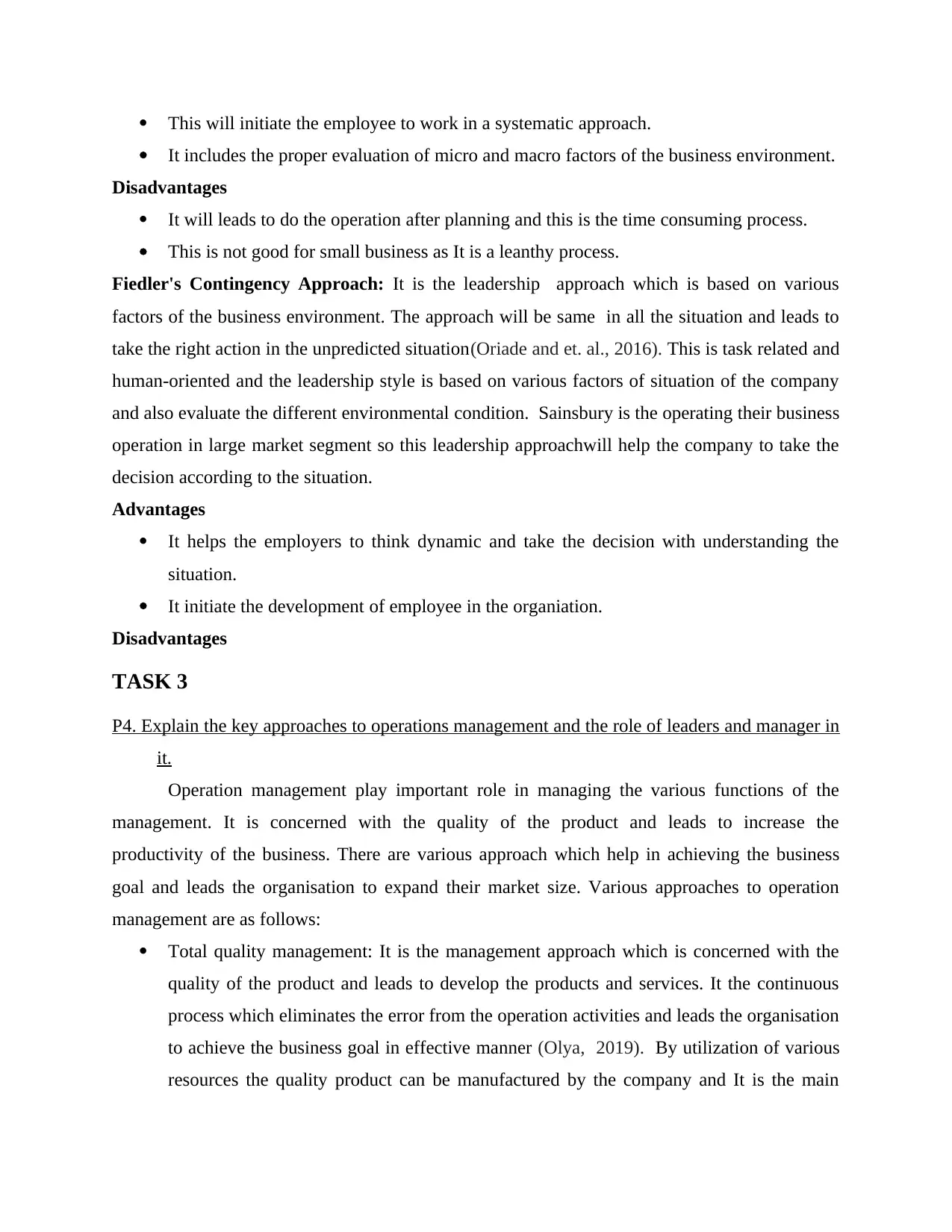
This will initiate the employee to work in a systematic approach.
It includes the proper evaluation of micro and macro factors of the business environment.
Disadvantages
It will leads to do the operation after planning and this is the time consuming process.
This is not good for small business as It is a leanthy process.
Fiedler's Contingency Approach: It is the leadership approach which is based on various
factors of the business environment. The approach will be same in all the situation and leads to
take the right action in the unpredicted situation(Oriade and et. al., 2016). This is task related and
human-oriented and the leadership style is based on various factors of situation of the company
and also evaluate the different environmental condition. Sainsbury is the operating their business
operation in large market segment so this leadership approachwill help the company to take the
decision according to the situation.
Advantages
It helps the employers to think dynamic and take the decision with understanding the
situation.
It initiate the development of employee in the organiation.
Disadvantages
TASK 3
P4. Explain the key approaches to operations management and the role of leaders and manager in
it.
Operation management play important role in managing the various functions of the
management. It is concerned with the quality of the product and leads to increase the
productivity of the business. There are various approach which help in achieving the business
goal and leads the organisation to expand their market size. Various approaches to operation
management are as follows:
Total quality management: It is the management approach which is concerned with the
quality of the product and leads to develop the products and services. It the continuous
process which eliminates the error from the operation activities and leads the organisation
to achieve the business goal in effective manner (Olya, 2019). By utilization of various
resources the quality product can be manufactured by the company and It is the main
It includes the proper evaluation of micro and macro factors of the business environment.
Disadvantages
It will leads to do the operation after planning and this is the time consuming process.
This is not good for small business as It is a leanthy process.
Fiedler's Contingency Approach: It is the leadership approach which is based on various
factors of the business environment. The approach will be same in all the situation and leads to
take the right action in the unpredicted situation(Oriade and et. al., 2016). This is task related and
human-oriented and the leadership style is based on various factors of situation of the company
and also evaluate the different environmental condition. Sainsbury is the operating their business
operation in large market segment so this leadership approachwill help the company to take the
decision according to the situation.
Advantages
It helps the employers to think dynamic and take the decision with understanding the
situation.
It initiate the development of employee in the organiation.
Disadvantages
TASK 3
P4. Explain the key approaches to operations management and the role of leaders and manager in
it.
Operation management play important role in managing the various functions of the
management. It is concerned with the quality of the product and leads to increase the
productivity of the business. There are various approach which help in achieving the business
goal and leads the organisation to expand their market size. Various approaches to operation
management are as follows:
Total quality management: It is the management approach which is concerned with the
quality of the product and leads to develop the products and services. It the continuous
process which eliminates the error from the operation activities and leads the organisation
to achieve the business goal in effective manner (Olya, 2019). By utilization of various
resources the quality product can be manufactured by the company and It is the main
Paraphrase This Document
Need a fresh take? Get an instant paraphrase of this document with our AI Paraphraser
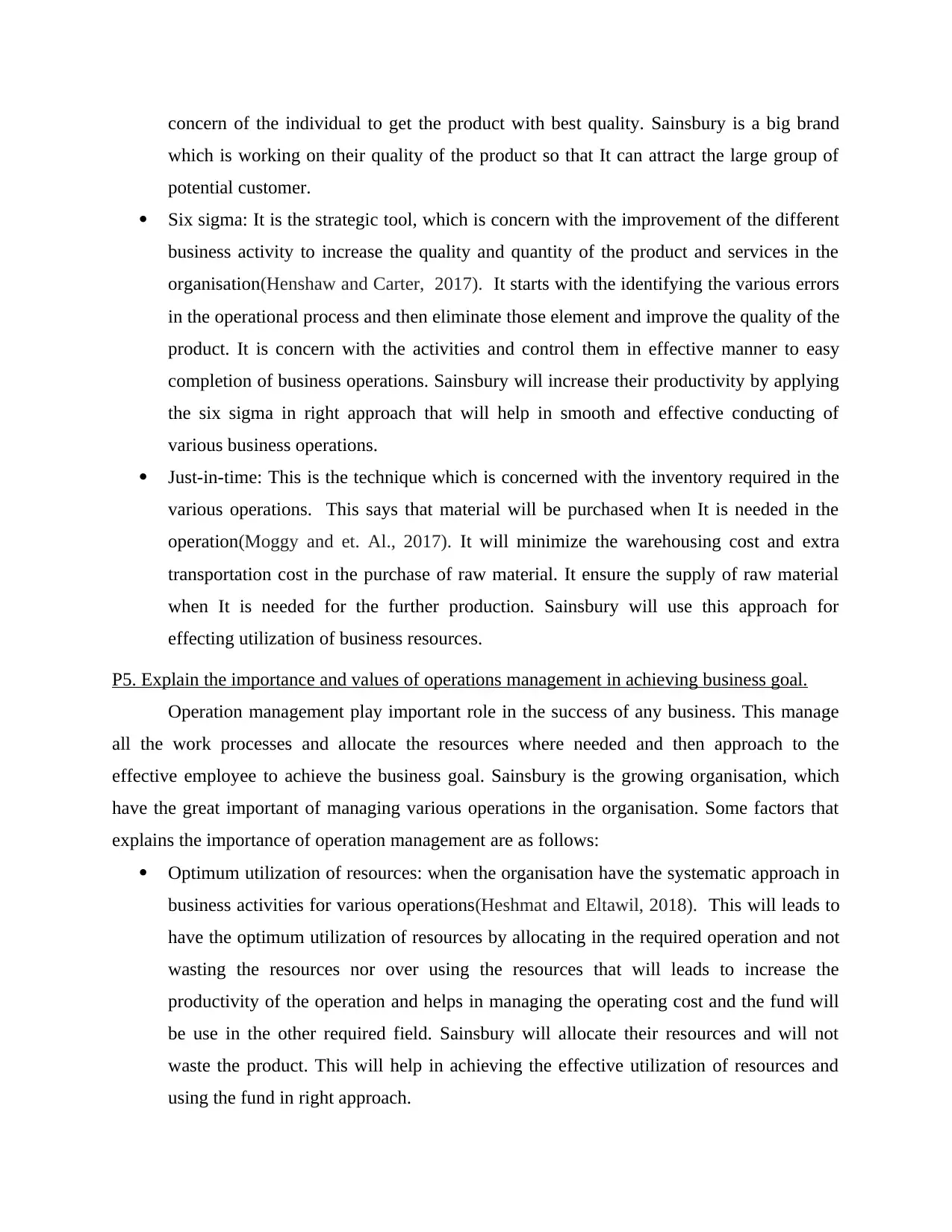
concern of the individual to get the product with best quality. Sainsbury is a big brand
which is working on their quality of the product so that It can attract the large group of
potential customer.
Six sigma: It is the strategic tool, which is concern with the improvement of the different
business activity to increase the quality and quantity of the product and services in the
organisation(Henshaw and Carter, 2017). It starts with the identifying the various errors
in the operational process and then eliminate those element and improve the quality of the
product. It is concern with the activities and control them in effective manner to easy
completion of business operations. Sainsbury will increase their productivity by applying
the six sigma in right approach that will help in smooth and effective conducting of
various business operations.
Just-in-time: This is the technique which is concerned with the inventory required in the
various operations. This says that material will be purchased when It is needed in the
operation(Moggy and et. Al., 2017). It will minimize the warehousing cost and extra
transportation cost in the purchase of raw material. It ensure the supply of raw material
when It is needed for the further production. Sainsbury will use this approach for
effecting utilization of business resources.
P5. Explain the importance and values of operations management in achieving business goal.
Operation management play important role in the success of any business. This manage
all the work processes and allocate the resources where needed and then approach to the
effective employee to achieve the business goal. Sainsbury is the growing organisation, which
have the great important of managing various operations in the organisation. Some factors that
explains the importance of operation management are as follows:
Optimum utilization of resources: when the organisation have the systematic approach in
business activities for various operations(Heshmat and Eltawil, 2018). This will leads to
have the optimum utilization of resources by allocating in the required operation and not
wasting the resources nor over using the resources that will leads to increase the
productivity of the operation and helps in managing the operating cost and the fund will
be use in the other required field. Sainsbury will allocate their resources and will not
waste the product. This will help in achieving the effective utilization of resources and
using the fund in right approach.
which is working on their quality of the product so that It can attract the large group of
potential customer.
Six sigma: It is the strategic tool, which is concern with the improvement of the different
business activity to increase the quality and quantity of the product and services in the
organisation(Henshaw and Carter, 2017). It starts with the identifying the various errors
in the operational process and then eliminate those element and improve the quality of the
product. It is concern with the activities and control them in effective manner to easy
completion of business operations. Sainsbury will increase their productivity by applying
the six sigma in right approach that will help in smooth and effective conducting of
various business operations.
Just-in-time: This is the technique which is concerned with the inventory required in the
various operations. This says that material will be purchased when It is needed in the
operation(Moggy and et. Al., 2017). It will minimize the warehousing cost and extra
transportation cost in the purchase of raw material. It ensure the supply of raw material
when It is needed for the further production. Sainsbury will use this approach for
effecting utilization of business resources.
P5. Explain the importance and values of operations management in achieving business goal.
Operation management play important role in the success of any business. This manage
all the work processes and allocate the resources where needed and then approach to the
effective employee to achieve the business goal. Sainsbury is the growing organisation, which
have the great important of managing various operations in the organisation. Some factors that
explains the importance of operation management are as follows:
Optimum utilization of resources: when the organisation have the systematic approach in
business activities for various operations(Heshmat and Eltawil, 2018). This will leads to
have the optimum utilization of resources by allocating in the required operation and not
wasting the resources nor over using the resources that will leads to increase the
productivity of the operation and helps in managing the operating cost and the fund will
be use in the other required field. Sainsbury will allocate their resources and will not
waste the product. This will help in achieving the effective utilization of resources and
using the fund in right approach.
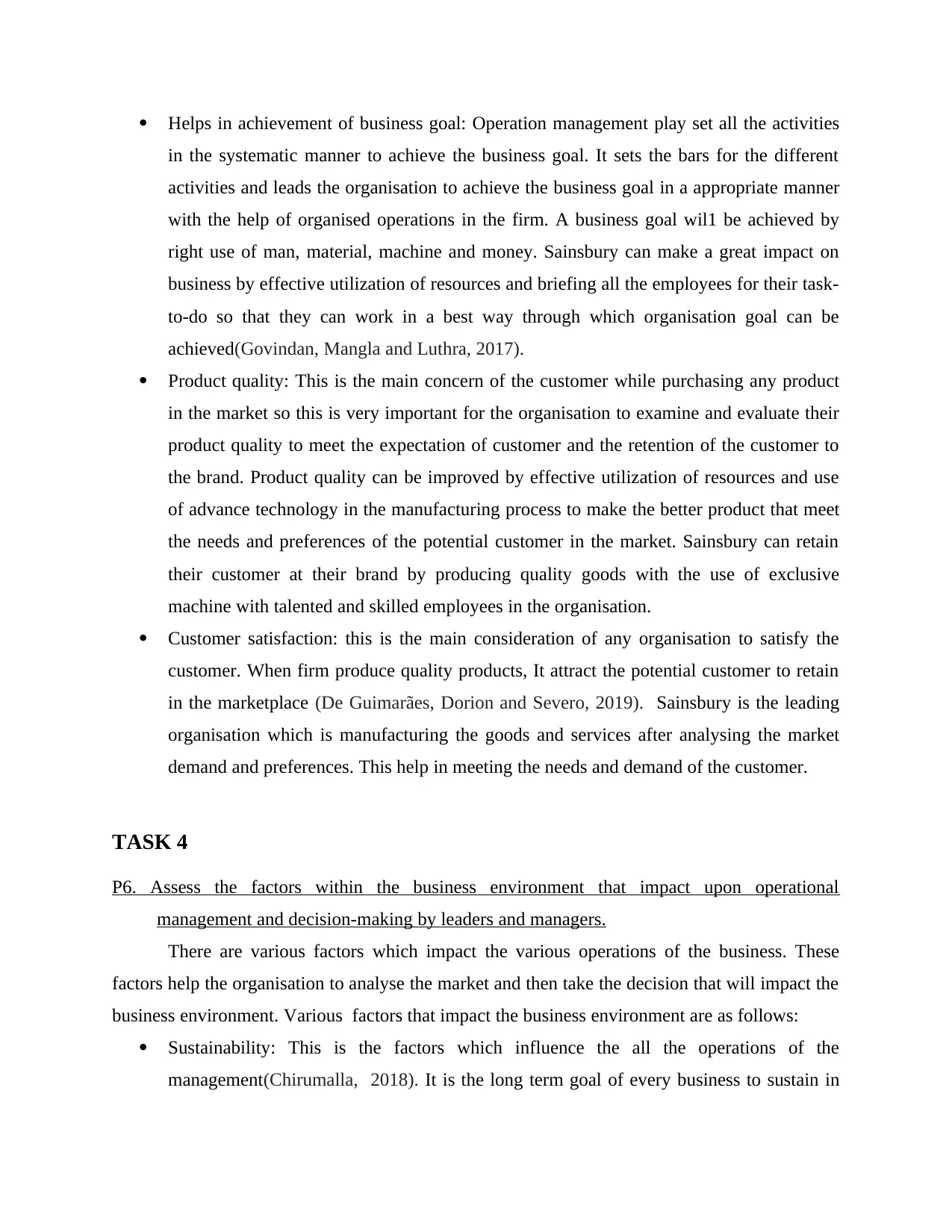
Helps in achievement of business goal: Operation management play set all the activities
in the systematic manner to achieve the business goal. It sets the bars for the different
activities and leads the organisation to achieve the business goal in a appropriate manner
with the help of organised operations in the firm. A business goal wil1 be achieved by
right use of man, material, machine and money. Sainsbury can make a great impact on
business by effective utilization of resources and briefing all the employees for their task-
to-do so that they can work in a best way through which organisation goal can be
achieved(Govindan, Mangla and Luthra, 2017).
Product quality: This is the main concern of the customer while purchasing any product
in the market so this is very important for the organisation to examine and evaluate their
product quality to meet the expectation of customer and the retention of the customer to
the brand. Product quality can be improved by effective utilization of resources and use
of advance technology in the manufacturing process to make the better product that meet
the needs and preferences of the potential customer in the market. Sainsbury can retain
their customer at their brand by producing quality goods with the use of exclusive
machine with talented and skilled employees in the organisation.
Customer satisfaction: this is the main consideration of any organisation to satisfy the
customer. When firm produce quality products, It attract the potential customer to retain
in the marketplace (De Guimarães, Dorion and Severo, 2019). Sainsbury is the leading
organisation which is manufacturing the goods and services after analysing the market
demand and preferences. This help in meeting the needs and demand of the customer.
TASK 4
P6. Assess the factors within the business environment that impact upon operational
management and decision-making by leaders and managers.
There are various factors which impact the various operations of the business. These
factors help the organisation to analyse the market and then take the decision that will impact the
business environment. Various factors that impact the business environment are as follows:
Sustainability: This is the factors which influence the all the operations of the
management(Chirumalla, 2018). It is the long term goal of every business to sustain in
in the systematic manner to achieve the business goal. It sets the bars for the different
activities and leads the organisation to achieve the business goal in a appropriate manner
with the help of organised operations in the firm. A business goal wil1 be achieved by
right use of man, material, machine and money. Sainsbury can make a great impact on
business by effective utilization of resources and briefing all the employees for their task-
to-do so that they can work in a best way through which organisation goal can be
achieved(Govindan, Mangla and Luthra, 2017).
Product quality: This is the main concern of the customer while purchasing any product
in the market so this is very important for the organisation to examine and evaluate their
product quality to meet the expectation of customer and the retention of the customer to
the brand. Product quality can be improved by effective utilization of resources and use
of advance technology in the manufacturing process to make the better product that meet
the needs and preferences of the potential customer in the market. Sainsbury can retain
their customer at their brand by producing quality goods with the use of exclusive
machine with talented and skilled employees in the organisation.
Customer satisfaction: this is the main consideration of any organisation to satisfy the
customer. When firm produce quality products, It attract the potential customer to retain
in the marketplace (De Guimarães, Dorion and Severo, 2019). Sainsbury is the leading
organisation which is manufacturing the goods and services after analysing the market
demand and preferences. This help in meeting the needs and demand of the customer.
TASK 4
P6. Assess the factors within the business environment that impact upon operational
management and decision-making by leaders and managers.
There are various factors which impact the various operations of the business. These
factors help the organisation to analyse the market and then take the decision that will impact the
business environment. Various factors that impact the business environment are as follows:
Sustainability: This is the factors which influence the all the operations of the
management(Chirumalla, 2018). It is the long term goal of every business to sustain in
⊘ This is a preview!⊘
Do you want full access?
Subscribe today to unlock all pages.

Trusted by 1+ million students worldwide
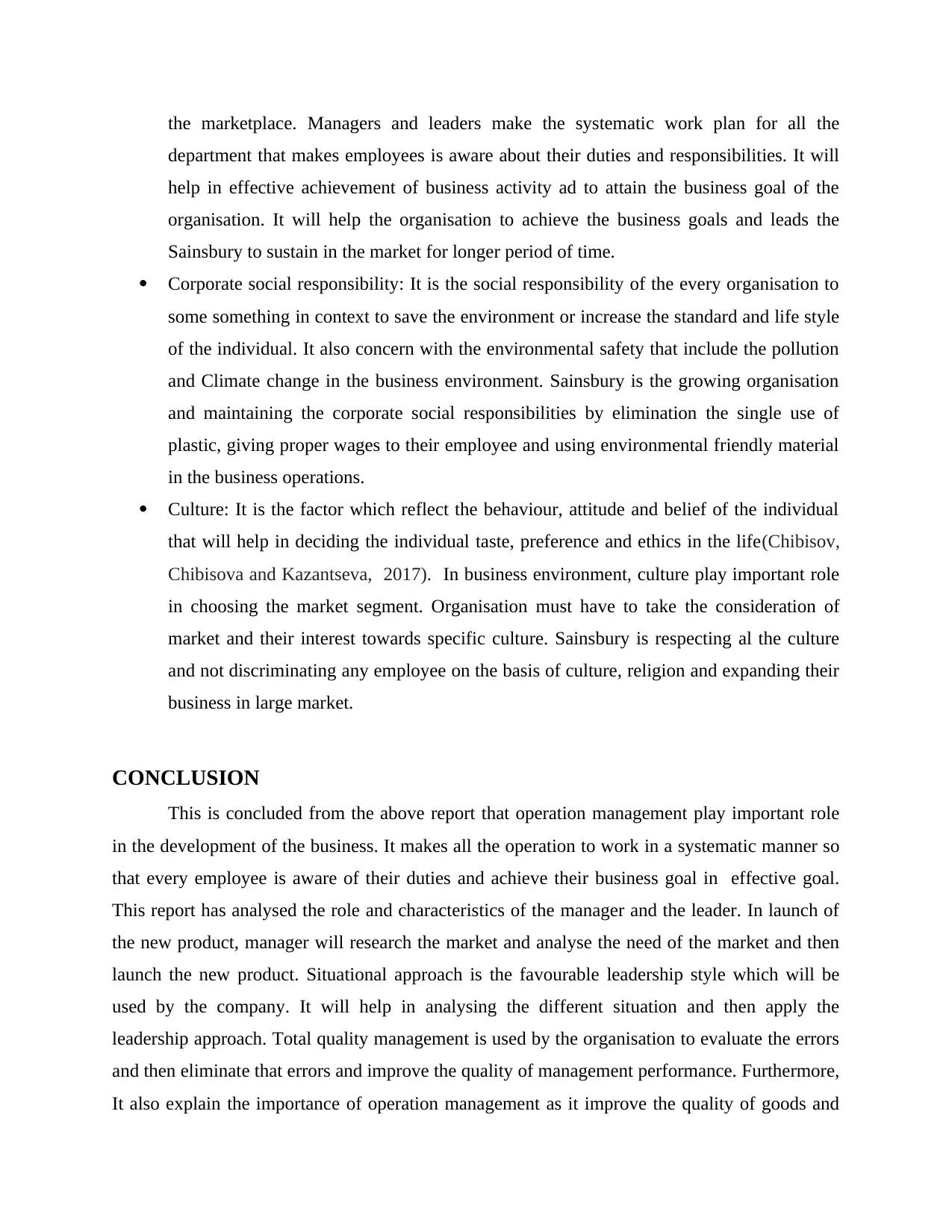
the marketplace. Managers and leaders make the systematic work plan for all the
department that makes employees is aware about their duties and responsibilities. It will
help in effective achievement of business activity ad to attain the business goal of the
organisation. It will help the organisation to achieve the business goals and leads the
Sainsbury to sustain in the market for longer period of time.
Corporate social responsibility: It is the social responsibility of the every organisation to
some something in context to save the environment or increase the standard and life style
of the individual. It also concern with the environmental safety that include the pollution
and Climate change in the business environment. Sainsbury is the growing organisation
and maintaining the corporate social responsibilities by elimination the single use of
plastic, giving proper wages to their employee and using environmental friendly material
in the business operations.
Culture: It is the factor which reflect the behaviour, attitude and belief of the individual
that will help in deciding the individual taste, preference and ethics in the life(Chibisov,
Chibisova and Kazantseva, 2017). In business environment, culture play important role
in choosing the market segment. Organisation must have to take the consideration of
market and their interest towards specific culture. Sainsbury is respecting al the culture
and not discriminating any employee on the basis of culture, religion and expanding their
business in large market.
CONCLUSION
This is concluded from the above report that operation management play important role
in the development of the business. It makes all the operation to work in a systematic manner so
that every employee is aware of their duties and achieve their business goal in effective goal.
This report has analysed the role and characteristics of the manager and the leader. In launch of
the new product, manager will research the market and analyse the need of the market and then
launch the new product. Situational approach is the favourable leadership style which will be
used by the company. It will help in analysing the different situation and then apply the
leadership approach. Total quality management is used by the organisation to evaluate the errors
and then eliminate that errors and improve the quality of management performance. Furthermore,
It also explain the importance of operation management as it improve the quality of goods and
department that makes employees is aware about their duties and responsibilities. It will
help in effective achievement of business activity ad to attain the business goal of the
organisation. It will help the organisation to achieve the business goals and leads the
Sainsbury to sustain in the market for longer period of time.
Corporate social responsibility: It is the social responsibility of the every organisation to
some something in context to save the environment or increase the standard and life style
of the individual. It also concern with the environmental safety that include the pollution
and Climate change in the business environment. Sainsbury is the growing organisation
and maintaining the corporate social responsibilities by elimination the single use of
plastic, giving proper wages to their employee and using environmental friendly material
in the business operations.
Culture: It is the factor which reflect the behaviour, attitude and belief of the individual
that will help in deciding the individual taste, preference and ethics in the life(Chibisov,
Chibisova and Kazantseva, 2017). In business environment, culture play important role
in choosing the market segment. Organisation must have to take the consideration of
market and their interest towards specific culture. Sainsbury is respecting al the culture
and not discriminating any employee on the basis of culture, religion and expanding their
business in large market.
CONCLUSION
This is concluded from the above report that operation management play important role
in the development of the business. It makes all the operation to work in a systematic manner so
that every employee is aware of their duties and achieve their business goal in effective goal.
This report has analysed the role and characteristics of the manager and the leader. In launch of
the new product, manager will research the market and analyse the need of the market and then
launch the new product. Situational approach is the favourable leadership style which will be
used by the company. It will help in analysing the different situation and then apply the
leadership approach. Total quality management is used by the organisation to evaluate the errors
and then eliminate that errors and improve the quality of management performance. Furthermore,
It also explain the importance of operation management as it improve the quality of goods and
Paraphrase This Document
Need a fresh take? Get an instant paraphrase of this document with our AI Paraphraser
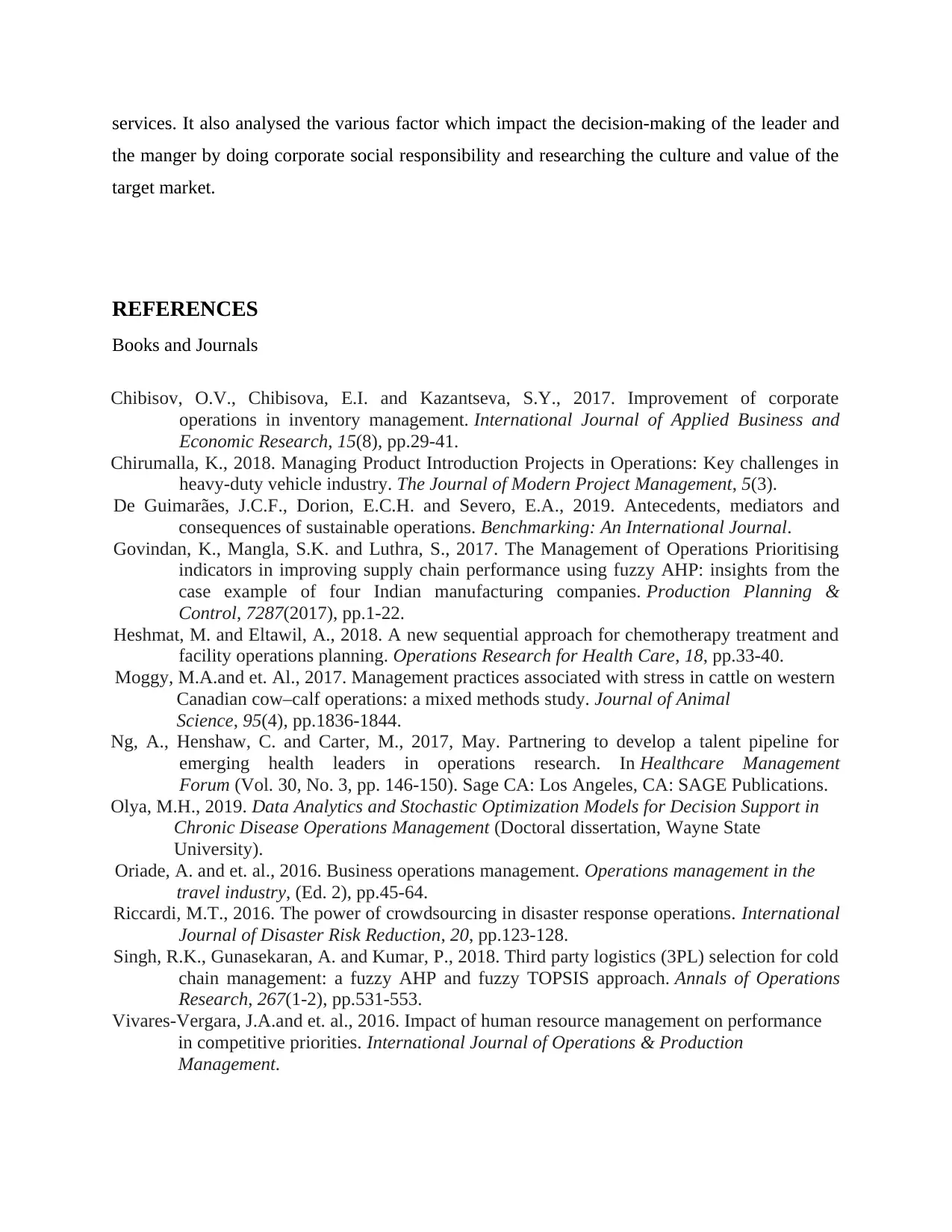
services. It also analysed the various factor which impact the decision-making of the leader and
the manger by doing corporate social responsibility and researching the culture and value of the
target market.
REFERENCES
Books and Journals
Chibisov, O.V., Chibisova, E.I. and Kazantseva, S.Y., 2017. Improvement of corporate
operations in inventory management. International Journal of Applied Business and
Economic Research, 15(8), pp.29-41.
Chirumalla, K., 2018. Managing Product Introduction Projects in Operations: Key challenges in
heavy-duty vehicle industry. The Journal of Modern Project Management, 5(3).
De Guimarães, J.C.F., Dorion, E.C.H. and Severo, E.A., 2019. Antecedents, mediators and
consequences of sustainable operations. Benchmarking: An International Journal.
Govindan, K., Mangla, S.K. and Luthra, S., 2017. The Management of Operations Prioritising
indicators in improving supply chain performance using fuzzy AHP: insights from the
case example of four Indian manufacturing companies. Production Planning &
Control, 7287(2017), pp.1-22.
Heshmat, M. and Eltawil, A., 2018. A new sequential approach for chemotherapy treatment and
facility operations planning. Operations Research for Health Care, 18, pp.33-40.
Moggy, M.A.and et. Al., 2017. Management practices associated with stress in cattle on western
Canadian cow–calf operations: a mixed methods study. Journal of Animal
Science, 95(4), pp.1836-1844.
Ng, A., Henshaw, C. and Carter, M., 2017, May. Partnering to develop a talent pipeline for
emerging health leaders in operations research. In Healthcare Management
Forum (Vol. 30, No. 3, pp. 146-150). Sage CA: Los Angeles, CA: SAGE Publications.
Olya, M.H., 2019. Data Analytics and Stochastic Optimization Models for Decision Support in
Chronic Disease Operations Management (Doctoral dissertation, Wayne State
University).
Oriade, A. and et. al., 2016. Business operations management. Operations management in the
travel industry, (Ed. 2), pp.45-64.
Riccardi, M.T., 2016. The power of crowdsourcing in disaster response operations. International
Journal of Disaster Risk Reduction, 20, pp.123-128.
Singh, R.K., Gunasekaran, A. and Kumar, P., 2018. Third party logistics (3PL) selection for cold
chain management: a fuzzy AHP and fuzzy TOPSIS approach. Annals of Operations
Research, 267(1-2), pp.531-553.
Vivares-Vergara, J.A.and et. al., 2016. Impact of human resource management on performance
in competitive priorities. International Journal of Operations & Production
Management.
the manger by doing corporate social responsibility and researching the culture and value of the
target market.
REFERENCES
Books and Journals
Chibisov, O.V., Chibisova, E.I. and Kazantseva, S.Y., 2017. Improvement of corporate
operations in inventory management. International Journal of Applied Business and
Economic Research, 15(8), pp.29-41.
Chirumalla, K., 2018. Managing Product Introduction Projects in Operations: Key challenges in
heavy-duty vehicle industry. The Journal of Modern Project Management, 5(3).
De Guimarães, J.C.F., Dorion, E.C.H. and Severo, E.A., 2019. Antecedents, mediators and
consequences of sustainable operations. Benchmarking: An International Journal.
Govindan, K., Mangla, S.K. and Luthra, S., 2017. The Management of Operations Prioritising
indicators in improving supply chain performance using fuzzy AHP: insights from the
case example of four Indian manufacturing companies. Production Planning &
Control, 7287(2017), pp.1-22.
Heshmat, M. and Eltawil, A., 2018. A new sequential approach for chemotherapy treatment and
facility operations planning. Operations Research for Health Care, 18, pp.33-40.
Moggy, M.A.and et. Al., 2017. Management practices associated with stress in cattle on western
Canadian cow–calf operations: a mixed methods study. Journal of Animal
Science, 95(4), pp.1836-1844.
Ng, A., Henshaw, C. and Carter, M., 2017, May. Partnering to develop a talent pipeline for
emerging health leaders in operations research. In Healthcare Management
Forum (Vol. 30, No. 3, pp. 146-150). Sage CA: Los Angeles, CA: SAGE Publications.
Olya, M.H., 2019. Data Analytics and Stochastic Optimization Models for Decision Support in
Chronic Disease Operations Management (Doctoral dissertation, Wayne State
University).
Oriade, A. and et. al., 2016. Business operations management. Operations management in the
travel industry, (Ed. 2), pp.45-64.
Riccardi, M.T., 2016. The power of crowdsourcing in disaster response operations. International
Journal of Disaster Risk Reduction, 20, pp.123-128.
Singh, R.K., Gunasekaran, A. and Kumar, P., 2018. Third party logistics (3PL) selection for cold
chain management: a fuzzy AHP and fuzzy TOPSIS approach. Annals of Operations
Research, 267(1-2), pp.531-553.
Vivares-Vergara, J.A.and et. al., 2016. Impact of human resource management on performance
in competitive priorities. International Journal of Operations & Production
Management.

⊘ This is a preview!⊘
Do you want full access?
Subscribe today to unlock all pages.

Trusted by 1+ million students worldwide
1 out of 12
Related Documents
Your All-in-One AI-Powered Toolkit for Academic Success.
+13062052269
info@desklib.com
Available 24*7 on WhatsApp / Email
![[object Object]](/_next/static/media/star-bottom.7253800d.svg)
Unlock your academic potential
Copyright © 2020–2025 A2Z Services. All Rights Reserved. Developed and managed by ZUCOL.





